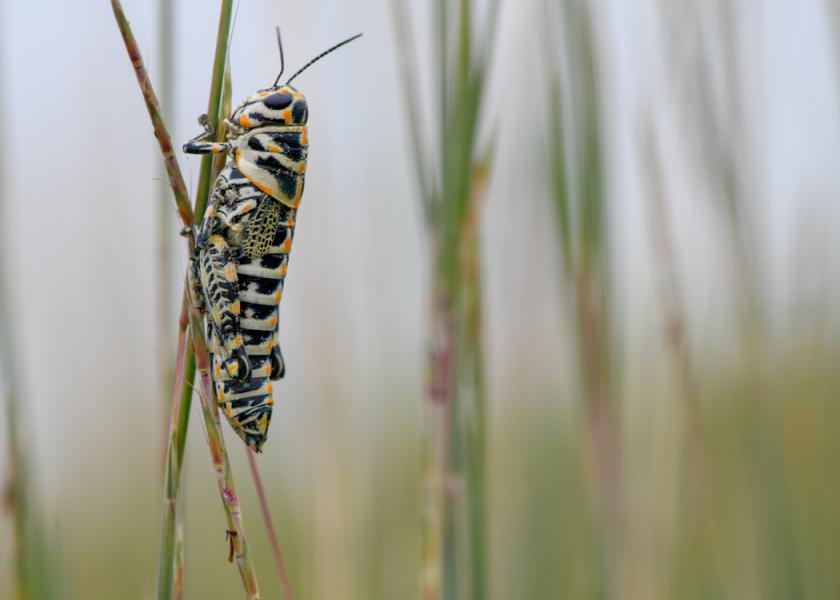Pasture Grasshoppers

Much of Nebraska has had several years of below normal precipitation, which may allow grasshoppers to become a problem.
The 2023 Rangeland Grasshopper Hazard Map (Fig 1) indicates ten counties in Nebraska that had fall adult grasshopper numbers averaging over 15 per square yard. These data are based on the 2022 adult survey, which is a good indicator of possible grasshopper issues for the summer of 2023. Economic thresholds for grasshopper densities in rangeland vary from 8 to 40 grasshoppers per square yard. The thresholds are influenced by several factors, including the cost of control product, projected forage yield, and the value of forage considered for treatment.
Grasshoppers consume up to 50% of their body weight every day in forage. A rate of just 2.7 grasshoppers per square yard equals 12,971 grasshoppers per acre. An acre with 69.7 grasshoppers per square yard equates to the consumption of forage by one cow per day.

Pasture grasshopper species that are most damaging are found in areas with less than 30 inches of annual rainfall. The western two-thirds of Nebraska fall into this rainfall category. With the occurrence of consecutive years of drought, grasshopper outbreaks are possible. The past several years southwestern, southcentral, and western Nebraska has experienced below normal precipitation. This type of weather pattern can play a large role in rangeland grasshopper outbreaks, and monitoring grasshopper numbers is important to figuring out what action may be required.
Monitoring
One of the better methods for determining grasshopper density is to count the number of grasshoppers using the square foot method. With this method, sample at multiple sites about 50 to 75 feet apart. Select a point several feet away and visualize a one-foot square area around the point. Walk toward the point, counting any grasshoppers you see in or jumping out of this area. Repeat 18 times, total the number of grasshoppers, and divide by 2. The resulting number will be the number of grasshoppers per square yard.
Life Cycle
The developmental stages of all grasshoppers include the egg, nymphal, and adult stages. Most species overwinter as eggs. Normally, grasshopper eggs will remain in the overwintering stage until the ground temperature reaches 50° to 55° Fahrenheit. Newly hatched grasshoppers look like miniature adults except they lack wings, and their sex organs are not developed. As young grasshoppers grow, they shed their skin (molt). Depending upon the species, they might molt four to six times, with five molts being the average. The rate at which nymphs develop is influenced by temperature and food quality. Most species reach the adult stage, 30 to 50 days after hatching.
Approximately 50 species of grasshoppers are found on rangeland in Nebraska, though generally fewer than 10 species ever reach economic levels, accounting for 95 percent of the damage. Grasshoppers defoliate grass by direct feeding on leaf and stem tissue and by cutting off leaves or stems.
Control
A grasshopper integrated pest management (IPM) program called Reduced Agent and Area Treatment (RAAT) was developed by researchers at the University of Wyoming to improve grasshopper control in pastures and rangeland. This chemical control strategy utilizes the insecticide Dimilin which interferes with the molting process of grasshoppers. Dimilin is applied in alternating strips, reducing application costs by 50 to 60% and reducing the amount of insecticide used by 65 to 70%, compared to conventional broadcast treatments. The RAAT system provides up to 85% control, depending upon rate of growth of the forage, the size of the grasshoppers and the coverage obtained.
For other grasshopper control product options, please contact your local UNL Extension Office. Before using any pesticide, please read and follow label instructions.
A request for technical assistance to evaluate the need for grasshopper control in rangeland may be submitted to USDA-APHIS, by contacting David Nielsen at (402) 434-2348 or by email at David.Nielsen@usda.gov
Anyone within the areas where the American burying beetle has been identified (28 Nebraska counties--see Figure 2) must contact the U.S. Fish and Wildlife Service before using insecticidal grasshopper control methods. The American burying beetle was listed as an endangered species in 1989 and downgraded to threatened in 2020. Though the status has changed, they are still considered a protected species, and insecticide application must follow federal guidelines.







